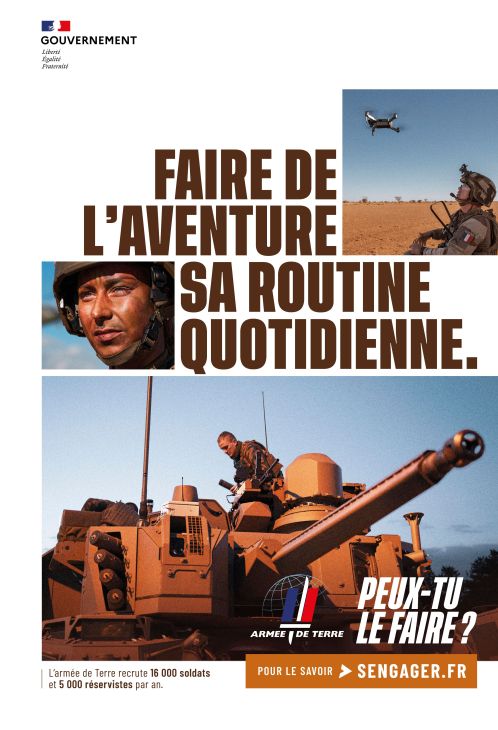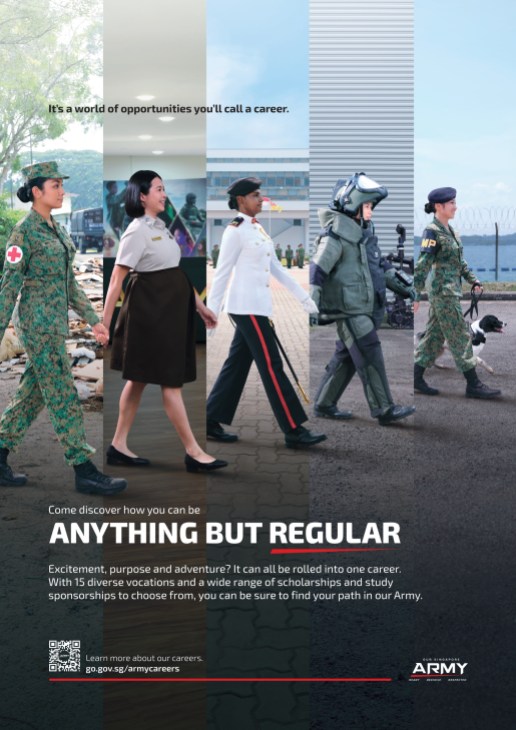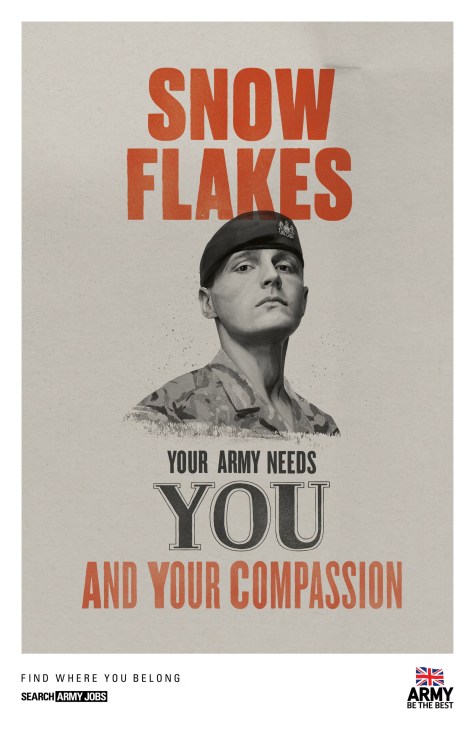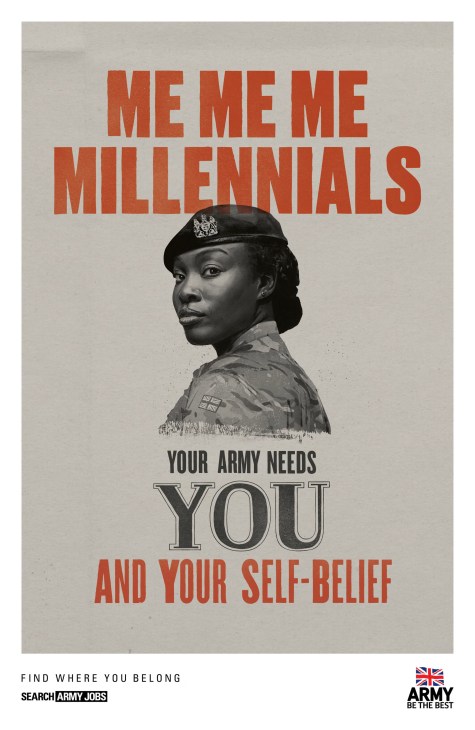How can today’s military recruitment strategies win over a generation that won’t fight?
With global defence forces struggling to fill their ranks, Monocle explores the bold, surprising and sometimes strange tactics being used to recruit Gen Z.
In 2024 global military expenditure hit a record $2.72trn (€2.37trn). While much of this was directed towards the development of 21st century weaponry, militaries are still in dire need of that most basic but increasingly difficult to procure resource: manpower. In Europe, where this personnel shortage is particularly acute, vanishingly small numbers seem to be interested in military service: a Gallup poll last year revealed that only 32 per cent of EU citizens would be willing to fight for their country in the event of a war. It’s a fact that is vastly complicated by the presence of war on the continent. To combat this apathy, governments are spending big on recruitment campaigns. The messaging and imagery tells us a lot about how a country sees itself, as well as the specific challenges that it faces.
Almost all of these ads are aimed at young people for whom patriotism might not be as powerful a pull as it once was. So, gone are the jingoistic slogans of yesteryear – “Your country needs you” and “Follow the flag” – and in their place are ones that appeal to feelings themselves, such as a desire for adventure or self-improvement: “Anything but regular” or “Be all you can be”.
Of course, though pressing, recruitment gaps in Europe and the US are not yet existential. This is not the case for countries at war. In Ukraine, where all men aged between 25-60 are required to register for conscription, there is a huge manpower shortage as the war of attrition with Russia moves towards its fourth year and many seek exemptions from the call-up. While conscription squads roam the streets looking for draft dodgers, the military is also getting creative with its advertising, trying to sell service as something cool and fun, rather than a death sentence.
In Russia, which has also seen forms of mobilisation mixed with a wider recruiting drive, most messaging focuses on the themes of masculinity and material gain. “Monthly payments starting at 204,000 rubles [€2,210],” are the last words to appear on screen in the campaign discussed here, which was released at a time when Russian battlefield losses in Ukraine were estimated to be as much as 700 a day.
In such circumstances, recruiters cannot, perhaps, afford to be anything other than blunt. But how can countries that are not yet at war persuade a cohort of people for whom military service has never seemed like a viable career path to join the army?
Here, we assess seven recent military recruitment campaigns from around the world, identifying how their ambition translates to overall messaging, as well as whether they have been successful with their creative choices. There is generally a widespread understanding in defence ministries across the globe that a military career must be rebranded to appeal to a new generation. But how best to achieve this? Let’s find out.
1.
France
Campaign: Can you do it?
Year: 2024
Agency: Dentsu Creative France, an advertising and public-relations firm based in Paris, which has produced work for Adobe and Ikea.
Messaging: This campaign for the French land army is about emphasising the variety and adventure of military life in the 21st century. The online component stresses that the army offers recruits 117 specialities in which to train, as well as detailed daily life in the force and invited potential recruits to try their hand at fitness events and team-based activities hosted in five French cities, including Paris and Marseille.


Ambition: Launched in September 2024, the campaign’s objective was to recruit 16,000 new soldiers and 5,000 reservists in the following year.
Does it work? At the time of writing, the French army has yet to release the recruitment figures for the year following the campaign. It certainly succeeds in making army life sound a little more fun than you might suspect.While many young people in Western countries are struggling with unemployment, a social life dominated by technology and a lack of purpose, an adventure and some structure might just seem appealing.
2.
Sweden
Campaign: You have what it takes.
Year: 2024
Agency: Nord DDB
Message: This is the first time that a Swedish military recruitment ad hasn’t featured a single soldier, weapon or battlefield. A woman gives a friend a piggyback across a bridge. Up flash the words, “Marching with a heavy bag…You have what it takes.” Next, we’re in a classroom where another woman is nodding off. Her friend throws a paper ball at her. “Assist your combat partner…You have what it takes,” insists the text. At a time when Sweden is rapidly rearming, this campaign is aimed squarely at young women, who make up less than 20 per cent of new recruits.



Ambition: The goal of the Swedish Armed Forces is for 30 per cent of its new recruits to be women by 2030. “You have what it takes” was conceived with this plan in mind.
Does it work? In 2024, women made up 19 per cent of the armed forces (the army, air force and navy combined), down from 24 per cent in 2023, but the numbers are heading in the right direction.
3.
Russia
Campaign: You’re a man. Act like it.
Year: 2023
Agency: In-house at Russia’s ministry of defence
Messaging: In this televised campaign, supermarket security guards, taxi drivers and fitness trainers are shown shape-shifting. “Did you really want to choose this path?” a super asks with menace. One flicker of the light and they’re transformed into soldiers, clad in military gear. Questioning the virility and value of everyday jobs, such as those of shopkeepers or chauffeurs, the campaign attempts to shame men across Russia into action, while depicting the military as an antidote to the humdrum existence of modern life.



Ambition: To drastically increase recruitment of professional soldiers. Though all Russian men aged 18 are required to complete 12 months of national service, these conscripts cannot be deployed to fight outside of Russia and were exempt from a first round of mobilisation in 2022. When this campaign launched, Russian losses in Ukraine were averaging almost 700 personnel a day. The defence ministry was forced into even more desperate attempts at recruitment, including commuting prisoners’ sentences in return for signing up and offering huge financial incentives.
Does it work? Sort of. The Kremlin avoided a potentially mutinous second round of mobilisation, with Vladimir Putin claiming that 490,000 soldiers were recruited in the 12 months up to December 2023, though he later revised that figure to “more than 300,000”. But as Russia expert Lucy Birge explains, “For most men, the money that they’re offered is the prime motivator for signing up.” This campaign advertises monthly pay of more than €2,000, nearly three times the national average, while the families of men killed at the front receive a payout of €45,000.
4.
Singapore
Campaign: Anything but regular.
Year: 2023
Agency: Tribal Worldwide Singapore
Messaging: With films showing military vehicles racing through vast plains, the Singapore army’s campaign dispels notions of military uniformity or a life of administrative boredom.


Ambition: Under the Enlistment Act, male Singaporean citizens and permanent residents are required to complete two years of national service when they hit 18 but too few of these conscripts are choosing to remain in the armed forces. This campaign targets Gen Z Singaporeans, breaking down preconceptions of an army career.
Does it work? The army claims there was a 47 per cent increase in voluntary sign-ups following the campaign.
5.
UK
Campaign: Your army needs you.
Year: 2019 – 2023
Agency: Karmarama
Message: Not the most current of the British Army’s recruitment campaigns but a clever departure from predictable messaging. This campaign riffs on the British First World War-era “Lord Kitchener Wants You” posters to subvert stereotypes of millennials as narcissistic, phone-addicted layabouts. It suggests that these traits are well suited to the army: being self-centred signals confidence, while “snow flakes” and “phone zombies” have compassion, focus and technical nous.


Ambition: “Your army needs you” formed part of a larger series aimed at British youngsters who might have considered their sexuality or religion to be a barrier to an army career.
Does it work? The campaign led to the army’s busiest three-month recruitment period in seven years. It was replaced in 2023 with the more traditional “You belong here” campaign.
6.
Ukraine
Campaigns: Fight in the Third Assault Brigade.
Year: 2025
Agency: An in-house media team of 12 full-time staff.
Message: “We’ll prepare you for any scenario,” reads a slogan emblazoned in orange. In the foreground, a Ukrainian soldier wearing sunglasses lies next to a slain alien; in the background, UFOs contend with anti-aircraft fire. This campaign uses both humour and cinematic imagery to portray military service as fun and adventurous. The message here is that those who enlist need not fear, including, even, an alien invasion. The implicit one is that as a soldier in the Ukraine’s army, they will be heroes fighting for justice and look good doing it.

Ambition: Though a new law introduced last year requires every Ukrainian man aged between 25 and 60 to sign up for some form of military service, recruitment shortages continue to undermine the country’s heroic resistance. This poster could be for an action film, with messaging that plays well with the younger audience that it seeks to recruit. It also evokes a kind of humorous stoicism that many have deployed since Russia’s invasion in 2022.
Does it work? In a sense, yes. The Third Assault Brigade averages about 500 new recruits per month, above the army average. But Ukraine still faces a challenge that frivolity might be incapable of solving, hence a reversion to coercion via conscription squads.
7.
USA
Campaign: Be all you can be.
Year: 2023
Agency: Army Enterprise Marketing Office/DDB Chicago
Message: The US Army is an exciting and stable career choice. You can defend your nation, solve problems, tend to the wounded and plan complex logistics. Serving in the army is a job for the ambitious, curious, adventurous and empowered. The campaign insists that steady wages and benefits including healthcare, tuition, job training and veteran support mean that the US Army is a path to a secure future.


Ambition: This was a return to tried-and-tested messaging after a controversial campaign that experimented with animated portraits of individual soldiers’ emotional lives. By rebooting an instantly identifiable slogan and jingle, the US Army sought to reassure the public that the institution had not strayed too far from tradition and to inspire a Gen Z audience to enlist by appealing to their desire for purpose, identity and impact.
Does it work? Yes. In the two years since the campaign’s launch, brand awareness increased from 50 to 75 per cent, according to the Army Enterprise Marketing Office. In June the US Army hit this year’s recruiting goal four months early, with 61,000 future soldiers under contract.That target was 10 per cent higher than last year’s.




